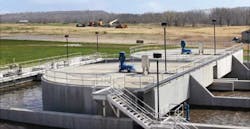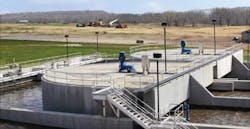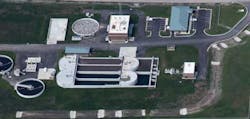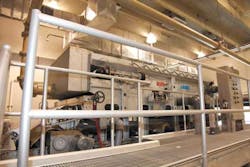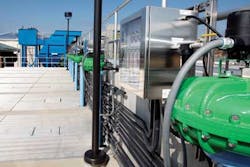Home to two large corporate headquarters and a large agricultural base, Northwest Arkansas is one of the fastest growing regions of the United States. Its population has tripled over the past 40 years from fewer than 140,000 in 1970 to 425,000 today.
The Northwest Arkansas Conservation Authority (NACA) was formed in 2002 to develop affordable regional solutions to the region's growing wastewater and biosolids treatment needs. NACA today represents 10 cities, including Bentonville, Rogers and Springdale. Its first project: a new 4 mgd regional wastewater collection and treatment system capable of serving two of its member cities, with plans to eventually expand it to 80 mgd to serve much of Northwest Arkansas.
The Issues
- The need in several communities for additional wastewater treatment capacity, either now or in the near future.
- Higher-than-normal concentrations of phosphorus and other nutrients in local soils, due largely to past land applications of poultry manure and wastewater biosolids.
- The expense and technical challenges associated with meeting significantly tightened nutrient discharge limits, especially in smaller Arkansas communities that operate septic or packaged treatment facilities.
- A lack of funding for a proposed $65 million wastewater treatment plant (WWTP) project.
Planning and Design
A 2004 study by Burns & McDonnell identified a 470-acre site along a creek south of Bentonville - the city in most immediate need of additional wastewater treatment capacity. This site not only provided adequate space for an 80 mgd treatment plant but would also allow NACA to construct community and environmental amenities, such as a regional education and outreach center, and wetlands or fish hatchery projects using wastewater treatment plant effluent.
Burns & McDonnell, in association with USI Consulting Engineers, was retained to engineer a new 4 mgd treatment plant - expandable to 6 mgd - along with the conveyance system that would eventually connect with member cities' collection systems. Plans call for the system to be eventually expanded to as much as 80 mgd to serve a 200-square-mile region in Northwest Arkansas.
Service Agreements, Financing
With no source of revenue, NACA needed a plan to finance the design and construction of the new plant, as well as its own administrative expenses, until the facilities could be placed in operation and begin generating revenue. Burns & McDonnell helped the authority meet this challenge through detailed project planning and coordination of lenders and customer cities. That included assisting NACA in arranging a bridge loan from a private Arkansas bank that covered planning costs but stipulated that design and construction could begin only after permanent financing was arranged.
To obtain permanent financing, NACA needed signed service agreements with its first two customer cities - Bentonville and Tontitown. Negotiated by Burns & McDonnell, these agreements provided both cities with an accurate forecast of NACA's service charges, stipulated the collection and treatment capacities and other rules regarding each one's use of NACA's facilities, and obligated each city to pay service charges to NACA according to its contribution to the total wastewater flow, as measured by flow meters placed where its sewerage connects to NACA's system.
To achieve buy-in, NACA took a collaborative approach to project planning, with the process led by a technical advisory committee comprising key technical representatives from NACA member cities. Once the final service agreements were in place, NACA obtained the conventional revenue bond financing needed to pay off the bridge loan principal and interest.
Regulatory Hurdles
Osage Creek, the stream that would receive the new plant's effluent, is a tributary of the Illinois River, which has been identified as an impaired waterway under section 303(d) of the federal Clean Water Act due to its high phosphorus content. Nearby treatment plants, including NACA city members Springdale and Rogers, were issued permits that limited total phosphorus to 1 mg/L, which is stricter than other regional watersheds due to the nutrients entering the river as point and non-point sources.
NACA anticipated the same would be required of its new plant. It learned otherwise when it applied for its construction and operating permit through the Arkansas Department of Environmental Quality (DEQ). During operating permit negotiations, U.S. Environmental Protection Agency, Oklahoma groups, and other stakeholders lobbied for a reduction in the permitted phosphorus discharge.
Issued just after construction bids were opened, the permit called for a total phosphorus limit of 1 mg/L for the first two years of plant operation. By June 2012, however, the limit dropped to 0.1 mg/L - one-tenth of the level anticipated by NACA and a level few wastewater treatment utilities in the nation have ever been required to meet. To meet EPA's revised phosphorus removal criteria, significant upgrades to the original design were required.
Phosphorus Removal
NACA commissioned Burns & McDonnell to complete a study, reviewing the technologies that were both capable of meeting such low total phosphorus limits and would also fit in the space intended for the conventional sand filters that had been part of the original design.
options
The study yielded three potential technologies:
- Submerged hollow fiber membranes, which use permeate pumps to pull water through the fiber membrane walls and discharge to a permeate pump suction header. This technology has been successfully applied for meeting low effluent phosphorus limits.
- Multi-barrier filtration, which uses tube settler clarification, followed by an upflow adsorption clarifier and mixed media filtration to achieve low effluent phosphorus limits. At the time of the study, this process had achieved low effluent phosphorus limits in pilot studies.
- Two-stage advanced filtration, which consists of two continuously backwashed upflow, deep bed sand filters with progressively finer sand media operated in series. This technology was considered to be the most proven approach for meeting low effluent phosphorus limits, based on the number of operating installations at the time.
Burns & McDonnell developed conceptual plans for the three options and compared them on a total annual cost basis. Two-stage advanced filtration was found to be the lowest cost option - costing 20% less than multi-barrier filtration and nearly 30% less than post-membrane filters. After considering costs, site constraints and the technologies' full-scale operating histories, NACA opted for two-stage advanced filtration.
Treatment Process
Screened and degritted wastewater is treated by a three-step biological treatment process consisting of anaerobic selector basins, anoxic basins, and aerobic oxidation basins. The anaerobic basins promote biological phosphorus removal. The anoxic basins allow denitrifying bacteria to remove nitrates from the nitrate-rich recycle stream returned from the aerobic oxidation basins, which grow bacteria that reduce biochemical oxygen demand, or BOD, and convert ammonia to nitrate. Oxidation basin aerators are automatically controlled by dissolved oxygen sensors near the internal recycle gates where flow is recycled into the anoxic zones from the oxidation basins.
The heart of the enhanced phosphorus removal system is the two-stage advanced filtration system following secondary clarification. The Dynasand D2® system manufactured by Parkson Corp. consists of two stages of continuously recirculating, deep bed, upflow sand filters, with the first stage having coarser sand media than the second stage.
Alum solution is added upstream of the filters to precipitate residual phosphorus leaving the biological treatment process before flow enters the filters. The continuous backwashing of the sand media keeps it clean of solids, allowing for the higher chemical dosage rates required for phosphorus removal to be reduced to very low levels. The continuous backwash stream from the filters is treated in a parallel plate clarifier that separates most of the backwash solids. The clarified backwash water is returned to the process flow and the solids are returned to the plant headworks.
Construction, Budget
Final design of the treatment plant and conveyance lines began in July 2007 and was completed 18 months later in January 2009, when construction bids were opened. The first phase was designed for 3.6 mgd average daily flow capacity, with a peak flow of 9 mgd. The original design also designated space for facilities and equipment to support a 50% expansion. NACA planned for the first drop of wastewater to be treated in fall 2010, just eight years after the regional partnership was formed.
The two-stage advanced filtration system was added to the plant just 18 months before its planned startup. That is when NACA's contractor learned it would need to replace the planned conventional sand filters with an activated sludge treatment process that would remove most of the ammonia, nitrogen and phosphorus from the flow. The changes would add about $4 million to the plant's construction costs. Thanks to an expedited schedule and a favorable construction market, the overall project stayed well within its original $64.5 million budget and 18-month construction schedule.
Startup
The gates at the Bentonville tie-in were opened on Nov. 29, 2010, allowing the first flows to reach the NACA Regional WWTP late that same afternoon. For the first eight months of operation, plant operators had to learn to manage the initial low flow rates from Bentonville and the force main connection from Tontitown until a second tie-in at Bentonville was complete.
During the first weeks of plant operation, flows averaged around 300,000 gallons per day, less than a quarter of the anticipated startup flow and 10% of the plant average design flow. After a week of filling basins, the plant started discharging flow, but not of the quality desired. Ammonia was still high and adequate phosphorus removal was sporadic due to the cycling of the filter pump station at low flows. The wastewater also had high influent nitrogen loads from landfill leachate directed to the Tontitown sewer.
With limited dilution and buffering from other flows, and wastewater temperatures nearing lows of 10 degrees Celsius, the plant was unable to achieve complete nitrification, leading to elevated ammonia discharges. Operators began feeding approximately 500 pounds of lime per day to the plant influent to add alkalinity for nitrification. With this chemical addition, and as temperatures began to increase in April, ammonia discharges began to drop precipitously.
In July 2011, Bentonville's second connection was completed, providing the much desired flow and pollutant loadings to jumpstart the treatment process. The additional loadings provided the needed kick to depress dissolved oxygen levels in the anaerobic and anoxic basins, and to enable biological nitrogen and phosphorus removal. Lime supplements were also no longer necessary. Effluent total nitrogen concentrations decreased to the desired levels as denitrifying bacteria thrived in the low dissolved oxygen environment. The effluent total nitrogen levels dropped significantly once influent loadings and flow increased to the levels originally anticipated for startup.
Up until this time, operators had been meeting the effluent phosphorus limits by chemical precipitation. The success of biological nitrogen removal allowed operators to decrease the alum addition and take advantage of the improving biological phosphorus removal. Though there was some variability in phosphorus removal during the trials, operators were able to decrease the alum dose by more than 50% due to biological phosphorus removal. This cut alum costs from approximately 25 cents to 10 cents per 1,000 gallons of treated water. By the end of 2011, an alum dose of 50 mg/L enabled the plant to achieve an average effluent total phosphorus concentration of ≤0.06 mg/L, which is the detection limit of the total phosphorus test procedure used by NACA.
The Results
Real-time continuous monitoring of phosphorus suggests the process is achieving effluent phosphorus well below 0.05 mg/L - easily meeting NACA's July 2012 permit limit of 0.1 mg/L. The new system not only produces higher quality effluent, it improves the effectiveness of the ultraviolet light disinfection process used to destroy pathogens in the wastewater before it is discharged to nearby Osage Creek. Long-term operational costs are also minimized by a supervisory control and data acquisition (SCADA) system that automates many plant operations. The entire plant can be operated with a staff of five, and operations can be monitored from home computers, if necessary.
NACA's experience demonstrates that it makes more economic sense to operate a large regional facility, rather than upgrading several smaller plants to meet the increasingly stringent requirements for phosphorus removal. With startup of these state-of-the-art facilities, NACA is well on its way to achieving its mission of developing affordable regional solutions to the area's water quality protection challenges.
